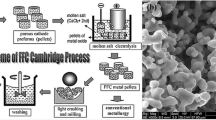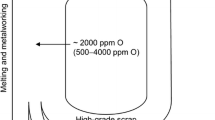Abstract
In this work, a consumable anode composed of a solid solution of titanium carbide and titanium monoxide was prepared via carbothermic reduction of TiO2. Upon electrolysis, the anode fed Ti2+ into solution and carbon monoxide was generated; no excess carbon remained to contaminate the melt. On the cathode, high-purity titanium (>99.9%) was produced. Our results suggest anode and cathode current efficiencies of 93.5% and 89% respectively, indicating that the method is viable and extremely cost-effective, potentially dropping the cost of titanium to near that of aluminum.
Similar content being viewed by others
References
W.J. Kroll: The production of ductile titanium. Trans. Am. Electrochem. Soc. 78, 35 (1940).
F.R. Clayton, G. Mamantov, and D.L. Manning: Electrochemical studies of titanium in molten fluorides. J. Electrochem. Soc. 120, 1193 (1973).
D. Wei, M. Okido, and T. Oki: Characteristics of titanium deposits by electrolysis in molten chloride-fluoride mixture. J. Appl. Electrochem. 24, 923 (1994).
T. Oishi, H. Kawamura, and Y. Ito: Formation and size control of titanium particles by cathode discharge electrolysis of molten chloride. J. Appl. Electrochem. 32, 819 (2002).
F. Lantelme, K. Kuroda, and A. Barhoun: Electrochemical and thermodynamic properties of titanium chloride solutions in various alkali chloride mixtures. Electrochim. Acta 44, 421 (1998).
F. Lantelme and A. Salmi: Electrochemistry of titanium in NaCl–KCl mixture and influence of dissolved fluoride ions. J. Electrochem. Soc. 142, 3451 (1995).
D.R. Sadoway: Electrochemical processing of refractory metals. JOM 43, 15 (1995).
N.A. Fried, K.G. Rhoads, and D.R. Sadoway: Transference number measurements of TiO2-BaO melts by stepped-potential chronoamperometry. Electrochim. Acta 46, 3351 (2001).
G.Z. Chen, D.J. Fray, and T.W. Farthing: Direct electrochemical reduction of titanium dioxide to titanium in molten calcium chloride. Nature 407, 361 (2000).
D.J. Fray: Emerging molten salt technologies for metals production. JOM 53, 26 (2001).
G.Z. Chen and D.J. Fray: Electro-deoxidation of metal oxides, in Light Metals, edited by J.L. Anjier (2001), p. 1147.
G.Z. Chen and D.J. Fray: Voltammetric studies of the oxygen-titanium binary system in molten calcium chloride. J. Electrochem. Soc. 149, E445 (2002).
S.L. Wang and Y.J. Li: Reaction mechanism of direct electro-reduction of titanium dioxide in molten calcium chloride. J. Electroanal. Chem. 571, 37 (2004).
T.H. Okabe, M. Nakamura, T. Oishi, and K. Ono: Electrochemical deoxidation of titanium. Metall. Trans. B 24, 449 (1993).
K. Ono and R.O. Suzuki: A new concept for producing Ti sponge: Caciothermic reduction. JOM 54, 59 (2002).
T.H. Okabe, T. Oishi, and K. Ono: Deoxidation of titanium aluminide by Ca–Al alloy under controlled aluminum activity. Metall. Trans. B 23, 583 (1992).
R.O. Suzuki: Calciothermic reduction of TiO2 and in situ electrolysis of CaO in the molten CaCl2. J. Phys. Chem. Solids 66, 461 (2005).
J.R. Myron and P. Palmerton: Electrorefining metallic titanium U.S. Patent No. 2 939 823 (1960).
B.N. Popov, M.C. Kimble, and R.E. White: Electrochemical behaviour of titanium(II) and titanium(III) compounds in lithium chloride/potassium chloride eutectic melts. J. Appl. Electrochem. 21, 351 (1991).
E. Wainer: Cell feed material for the production of titanium U.S. Patent No. 2 868 703 (1959).
E. Wainer and C. Heights: Ohio: Production of titanium U.S. Patent No. 2 722 509 (1955).
J.H. Christle, J.A. Turner, and R.A. Osteryoung: Square wave voltammetry at the dropping mercury electrode: Theory. Anal. Chem. 49, 1899 (1977).
S.I. Tokumoto, E. Tanaka, T. Kikuchi, K. Ogisu, and T. Tsumori: Method of adjust a fused salt electrolytic bath U.S. Patent No. 4 113 582 (1978).
Author information
Authors and Affiliations
Corresponding author
Rights and permissions
About this article
Cite this article
Jiao, S., Zhu, H. Novel metallurgical process for titanium production. Journal of Materials Research 21, 2172–2175 (2006). https://doi.org/10.1557/jmr.2006.0268
Received:
Accepted:
Published:
Issue Date:
DOI: https://doi.org/10.1557/jmr.2006.0268




